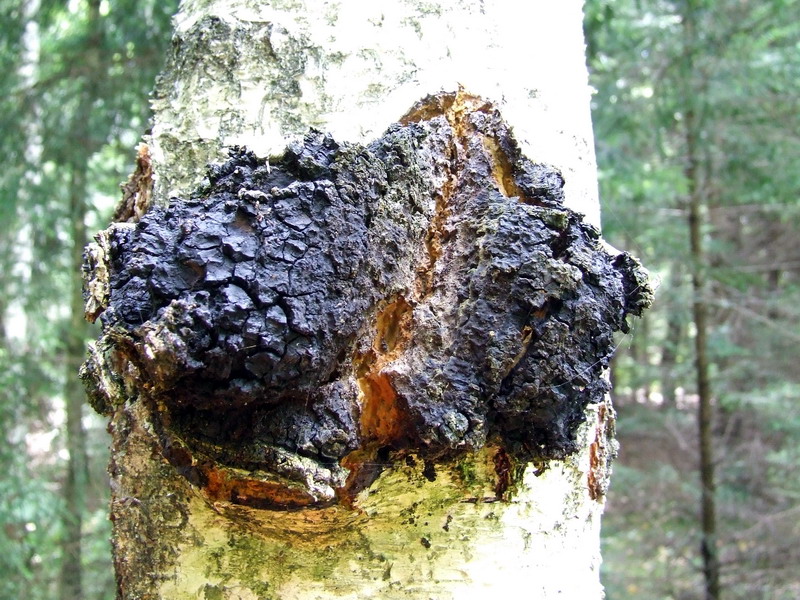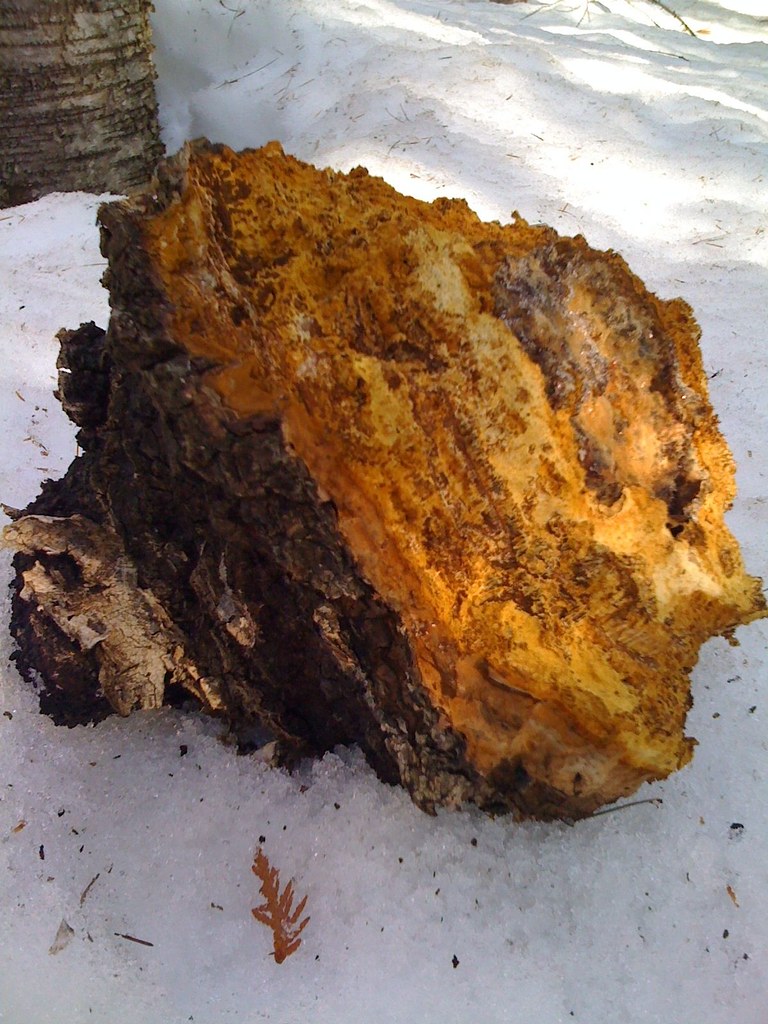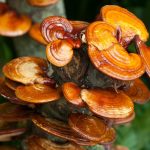Chaga | 10 Reasons to Call it the “King of Medicinal Mushrooms”

Chaga (Inonotus Obliquus)–otherwise known as “clinker polypore”– is a highly medicinal mushroom that grows predominantly on birch trees (usually over 40 years in age) in colder climates across the Northern Hemisphere. It might not look like a mushroom, because it’s actually a dense black mass that is the mycelia of the nonparasitic fungus. Botanists and taxonomists still question if it should be considered a mushroom at all. Chaga is gaining popularity for its taste (as chaga tea) as well as for its medicinal properties, which have long been known in the East, where chaga has been used for centuries by people in Siberia, Russia, and other parts of Asia. This medicinal mushroom can be consumed as a tea, liquid extract, powder, supplemental pill, and is even used for pet health.

Chaga has a hard and cracked black exterior, which looks like burnt charcoal or burnt marshmallow. This is called the sclerotium (above). The interior of chaga is often softer, spongier, and has a rusty yellow or brownish color that can be seen when it’s removed from the tree and/or broken apart (below).
Known as the “King of Medicinal Mushrooms,” chaga is the second most antioxidant-rich food in the world aside from chocolate. Although research is ongoing, credible studies have shown that chaga may provide a number of health benefits. Here is a list of ten of them:
1. Immunity Boosting and Cancer Fighting
Chaga mushrooms are renowned for improving immune function. Also a strong antibacterial and antiviral, chaga has proved helpful in preventing and recovering from cold and flu. Chaga also contains melanin, which helps fight against radiation and tumors.
2. Improves Diabetic Health
Animal studies show that chaga extract reduces symptoms of diabetes including high blood glucose, free fatty acids, total cholesterol, and (bad) low-density lipoprotein (LDL) cholesterol. Chaga extract increases (good) high-density lipoprotein (HDL) cholesterol and insulin levels in the livers of diabetic mice. This helps prevent high blood sugar levels and diabetic complications.
3. Reduces Inflammation
Chaga mushrooms are anti-inflammatory due to their high levels of antioxidants, which combat free radicals and prevent cellular damage.
4. Anti-aging & Skin
Chaga gets its distinctive dark color because of its very high melanin content. Melanin is a powerful antioxidant that is known to protect the genes and the DNA. Melanin is also the main pigment present in our skin. Chaga’s melanin content may even enhance the health of your skin, keeping it beautiful and  supple. It can help protect both the skin and hair from sun damage and might even help diminish age spotting.
supple. It can help protect both the skin and hair from sun damage and might even help diminish age spotting.
5. Ulcers and Gastritis
Because of its anti-inflammatory and immune boosting abilities, chaga has traditionally been used to support intestinal health and treat ulcers. According to research, chaga might be a useful alternative treatment for ulcers and inflammatory bowel disease (IBD). Oxidative stress from free radicals and low antioxidant levels can contribute to IBD. Chaga extract reduces oxidative stress in lymphocytes from both healthy individuals and IBD patients. Chaga also reduces inflammation in colon cells, which shows promise in the treatment of IBD.
6. Improved Cardiovascular and Metabolic Health
Chaga contains the compound betualin, which helps lower cholesterol and balances blood sugar by increasing insulin sensitivity.
7. Detoxification
Chaga also contains high levels of a very powerful antioxidant known as Superoxide Dismutase (SOD), which studies have shown is important for cleansing the liver.
8. Stress Support
Chaga helps the body adapt and respond to stressors by having a normalizing effect on the body. This mushroom is highly regarded as an effective herbal adaptogen. Adaptogens are herbal components that control the adrenal system of the body. They manage how bodily hormones react to stress and anxiety. They help the body to deal with anxiety by fighting fatigue caused by stress. Over time, adaptogens are ideal stress relievers because of their natural attributes. Health experts and practitioners do not hide their preference for herbal adaptogens, with chaga being among the most recommended.
9. Aids Digestion
Chaga stimulates bile flow, which is important for fat digestion. It also reduces inflammation in the digestive tract. It helps relieve indigestion and other digestive pain while keeping the digestive system working smoothly.
10. Increases Physical Endurance
Animals studies determined that compounds in chaga increased exercise tolerance. Animals that were given chaga extract were able to swim for a longer period of time when compared to a control group. The animals treated with chaga also had higher energy stores in the muscles and liver.
Chaga polysaccharides significantly reduce blood lactate levels while exercising. This may also help to boost endurance, since accumulation of lactate in the body can cause fatigue. Chaga extract also decreases blood urea nitrogen levels, which can otherwise contribute to fatigue as well.

In order to reap the medicinal benefits of chaga mushrooms, proper preparation is crucial. This is because the cell walls of chaga contain chitin, which is indigestible and therefore must be broken down.
Chaga is commonly consumed in tea form made with whole chunks, liquid extract, extract powder, or prepared tea bags. If you are using fresh harvested chaga, it should be infused in hot water for at least 1 hour before consuming, and longer if you are brewing cold tea, for the full extraction of medicinal compounds. Once the tea is brewed, you can pull out the chunks and set them aside for later use. You can keep using these chunks until the extract loses its dark color.
It should be noted that this mushroom rarely fruits, and it grows very slowly; therefore this fungus is rapidly becoming scarce in the more accessible areas where it was once relatively common. This is reason alone to buy supplements or chunks of chaga from cultivators who grow it on their own. If you do want to harvest chaga yourself, please harvest responsibly and respectfully and with care. We recommend only harvesting it in areas where it is plentiful; only harvesting it from a small percentage of the fungi growing in the area; and only harvesting part of any given conk, leaving 50% or more of it intact.
You can find more information on chaga and our recommended chaga supplements here.
Thank you for reading, and please, chaga responsibly.
–MM








Really excited to see this website to learn more about organic holistic medicines. Nice going.
Thanks!
We strongly agree with the value of this wonderful creation. All wild crafted, sustainable harvested, in the White Mountains of New Hampshire.
Thank you, Alfred!
Thank you for all the information on the wonderful virtues of this medicinal fungus. Can you please expand more about the sustainability of harvesting it as I have great concerns that it’s current popularity outways it’s abundance in the wild. You mention people selling this fungus as a result of cultivation. I haven’t found such a place and would appreciate it if you could point a few companies out to me and the readers.